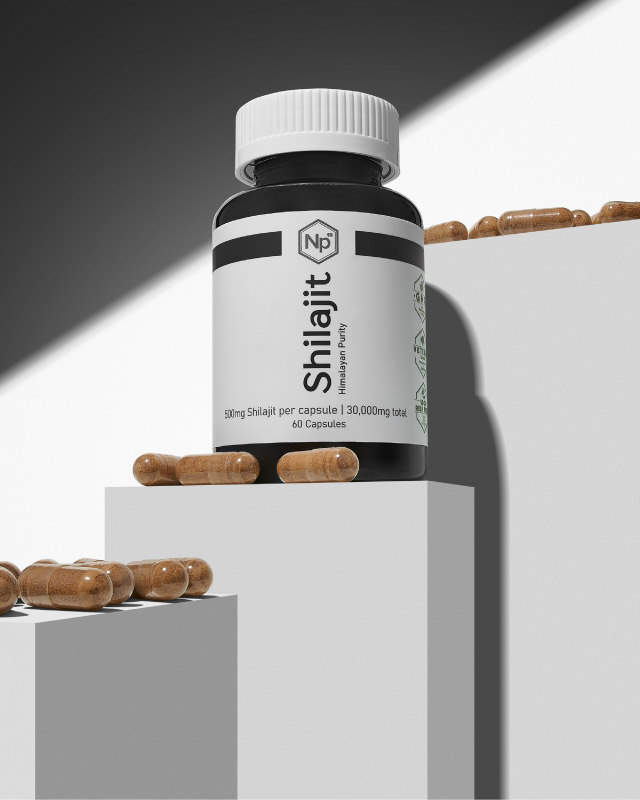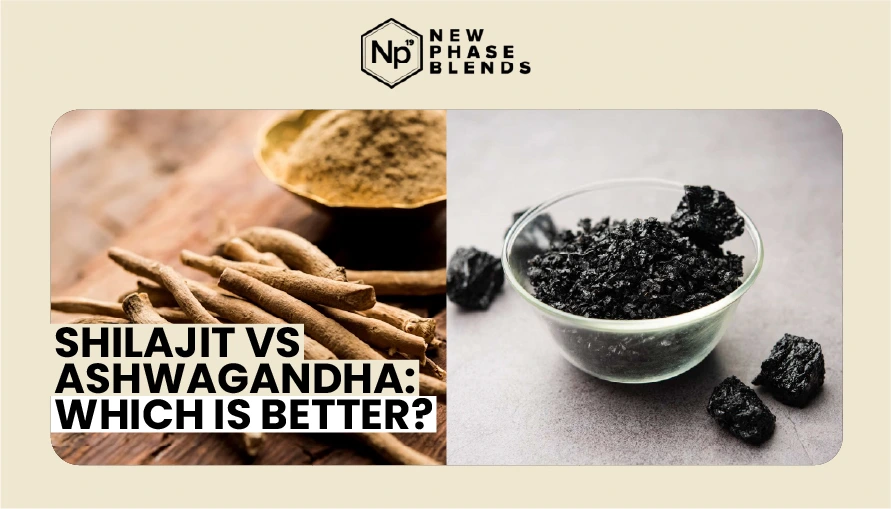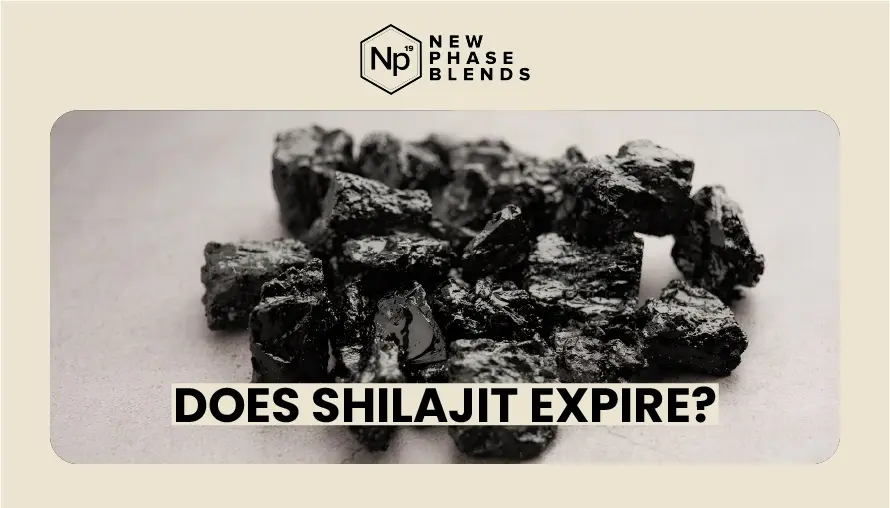Are you curious about shilajit but uncertain whether the centuries-old claims about this dark, resinous substance have any scientific merit? You’re not alone. As interest in natural supplements grows, many health-conscious consumers want to understand not just what shilajit does, but exactly how it works in the body before adding it to their wellness routine. After studying numerous scientific papers on traditional remedies, New Phase Blends has found that shilajit stands out as one of the few ancient supplements with growing modern scientific support.
By the end of this article, you’ll understand the key bioactive compounds in shilajit, how they interact with your body’s systems, and what the latest research reveals about this intriguing natural substance.
What Is Shilajit?
Shilajit (pronounced shil-ah-jeet) is a sticky, tar-like substance that slowly exudes from rocks in mountainous regions, primarily the Himalayas, Altai, Caucasus, and other mountain ranges across Asia. Its name derives from Sanskrit, meaning “rock-invincible,” reflecting both its origin and purported strength-giving properties.

Far from being simply mountain tar, shilajit is a complex matrix formed over centuries through the decomposition of plant matter and minerals. This slow geological process creates a unique substance with a remarkable biochemical profile. If you want to learn more about the basics of shilajit, check out our shilajit guide.
The Biochemical Makeup of Shilajit
What makes shilajit particularly interesting to researchers is its complex composition. The primary active components include:
- Fulvic Acid (40-60%): The predominant bioactive compound
- Dibenzo-α-pyrones: Powerful metabolites with antioxidant properties
- Humic Acid: A complex mixture of many different acids
- Minerals: Over 84 ionic minerals including zinc, magnesium, and potassium
- Amino Acids: Contains numerous essential and non-essential amino acids
- Polyphenols: Plant-based micronutrients with antioxidant activity
This unique composition explains why shilajit doesn’t work like single-compound supplements. Instead, it functions as a comprehensive biological matrix, with compounds that work synergistically.
How Does Shilajit Work in the Body?
Understanding how shilajit works requires examining several distinct but interconnected mechanisms. Research points to five primary ways shilajit interacts with human physiology.
Cellular Energy Production Enhancement
At the cellular level, shilajit appears to significantly impact energy production. Research published in the Journal of Ethnopharmacology demonstrates that dibenzo-α-pyrones in shilajit help preserve and enhance mitochondrial function.
The mitochondria are your cells’ power plants, converting nutrients into ATP (adenosine triphosphate), the energy currency of your body. Shilajit’s compounds support this process in several ways:
- They help transport electrons in the mitochondrial respiratory chain
- They enhance the efficiency of energy conversion
- They help protect mitochondria from oxidative damage

This mechanism explains why many users report improved energy levels and reduced fatigue when taking shilajit regularly. It’s not a stimulant effect like caffeine, but rather an optimization of your body’s natural energy production systems.
Mineral Delivery System
One of the most fascinating aspects of how shilajit works lies in its fulvic acid content. Fulvic acid acts as a remarkable mineral delivery system through a process called chelation.
In chelation, fulvic acid molecules bind to minerals and trace elements, creating structures that can more easily penetrate cell membranes. This enhances bioavailability in two critical ways:
First, it helps transport minerals across the intestinal lining, improving absorption rates. Second, it facilitates the delivery of these nutrients directly into cells where they’re needed.
This mineral transport function is particularly significant because many people suffer from subclinical mineral deficiencies despite taking supplements. The minerals in standard supplements often pass through the digestive system without being properly absorbed. Shilajit’s fulvic acid helps overcome this limitation.
Antioxidant and Anti-Inflammatory Actions of Shilajit
Modern research on shilajit consistently highlights its powerful antioxidant properties. Multiple compounds in shilajit, including fulvic acid and dibenzo-α-pyrones, neutralize free radicals and reduce oxidative stress.
A study published in Phytotherapy Research (2015) demonstrated that shilajit activates native antioxidant systems within the body, specifically enhancing superoxide dismutase (SOD), catalase, and glutathione peroxidase activity. These enzymes form your body’s primary defense against oxidative damage.
Beyond direct antioxidant action, shilajit also exhibits anti-inflammatory properties by modulating inflammatory cytokines. This dual action may explain the traditional use of shilajit for joint health and inflammatory conditions.
Hormonal Regulation
Research suggests that shilajit may influence hormonal balance, particularly in relation to stress hormones and testosterone. A randomized, double-blind study published in Andrologia (2016) found that men taking purified shilajit for 90 days experienced significantly increased testosterone levels compared to the placebo group.
The mechanism appears to involve:
- Supporting the hypothalamic-pituitary-adrenal (HPA) axis function
- Potentially increasing the production of sex hormones
- Modulating cortisol levels during periods of stress
These hormonal effects may contribute to shilajit’s traditional reputation as a rejuvenative tonic and explain why it’s frequently used to support healthy aging and vitality.
Detoxification Support
The humic and fulvic acids in shilajit appear to support the body’s natural detoxification processes. These compounds can bind to toxic heavy metals and other environmental pollutants, potentially helping to remove them from the body.
Additionally, research indicates that shilajit may support liver function, which is central to the body’s detoxification systems. A study in the Journal of Ethnopharmacology (2010) found that shilajit exhibited hepatoprotective effects, helping to shield liver cells from damage.
Scientific Research on Shilajit’s Health Benefits
While traditional Ayurvedic medicine has used shilajit for centuries, modern scientific research is now validating many of these traditional applications. Below, we cover what some of the current research tells us about specific health benefits of shilajit. I must say, there seems to be a lot of great benefits for shilajit products.
Cognitive Function and Brain Health
Emerging research suggests that shilajit may support brain health through multiple mechanisms. Its fulvic acid content appears to reduce the accumulation of tau protein, which is implicated in Alzheimer’s disease. Additionally, the antioxidant properties of shilajit may help protect neurons from oxidative damage.
According to a recent study published in the International Journal of Alzheimer’s Disease (2018) found that fulvic acid in shilajit showed potential to block tau self-aggregation, suggesting possible applications in neurodegenerative conditions.
Physical Performance and Recovery
Several studies have examined shilajit’s effects on physical performance. Research published in the Journal of Medicinal Food (2019) found that shilajit supplementation improved muscle recovery by enhancing the regeneration of muscles after exercise.
The ATP-enhancing properties of dibenzo-α-pyrones may explain these effects, along with improved oxygen delivery to tissues and enhanced removal of exercise-related waste products.
Healthy Aging Support
Traditional medicine systems have long valued shilajit as an anti-aging substance. Modern research suggests there may be scientific merit to these claims through several mechanisms:
- Protection against cellular damage from free radicals
- Support for mitochondrial function, which typically declines with age
- Potential enhancement of collagen production through mineral delivery
These mechanisms align with current understandings of the aging process, particularly the free radical theory of aging and the importance of mitochondrial health in longevity.
Common Misconceptions About How Shilajit Works
Despite growing research, several misconceptions persist about shilajit:
Misconception 1: Shilajit Works Immediately
Unlike stimulants that produce immediate effects, shilajit typically requires consistent use over time to deliver its benefits. Many of its mechanisms involve gradual optimization of cellular functions rather than acute stimulation.
Research suggests that significant benefits may take 2-8 weeks to manifest, depending on the individual and the quality of the shilajit being used.
Misconception 2: All Shilajit Products Are Equally Effective
The bioactivity of shilajit depends heavily on proper purification and processing. Raw, unpurified shilajit may contain contaminants and offer significantly lower concentrations of active compounds.
Studies showing benefits typically use purified shilajit with standardized fulvic acid content. The extraction method and purification process significantly impact the presence and preservation of bioactive compounds.
Misconception 3: Shilajit Is Just Another Mineral Supplement
While shilajit does contain minerals, viewing it merely as a mineral supplement misses its complex and synergistic nature. The interaction between fulvic acid, dibenzo-α-pyrones, and other compounds creates effects that exceed what minerals alone could provide.
How to Maximize Shilajit’s Effectiveness
Based on scientific understanding of how shilajit works, here are some evidence-based recommendations for maximizing its effectiveness:
Take shilajit consistently for at least 8 weeks to allow its cumulative effects to develop. The research showing significant benefits typically involves daily supplementation over several months.
Consider timing your intake. Some research suggests taking shilajit on an empty stomach may enhance absorption of its bioactive compounds, particularly the fulvic acid component.
Verify purity and standardization. Look for products that specify their fulvic acid content and have been tested for heavy metals and other contaminants.
Stay hydrated when taking shilajit, as water helps activate many of its water-soluble components and supports the transport functions of fulvic acid.
Conclusion: The Emerging Science of an Ancient Remedy
The science behind how shilajit works reveals a fascinating intersection of traditional knowledge and modern biochemistry. As research continues to uncover the mechanisms behind this complex substance, we gain greater appreciation for its potential applications in health and wellness.
While shilajit shows promise for supporting energy production, mineral utilization, antioxidant activity, and healthy aging, it’s important to approach it with realistic expectations. Its effects develop gradually through optimization of cellular functions rather than through immediate stimulation.
As with any supplement, quality matters significantly, and consultation with healthcare providers is recommended, particularly for those with existing medical conditions or taking medications.
The growing body of research on shilajit represents an exciting validation of traditional medicine through modern scientific methods, highlighting how ancient wisdom can sometimes anticipate discoveries that science is only now beginning to understand.






















